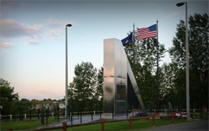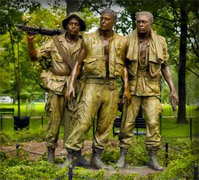Agent Orange
|
Agent Orange — or Herbicide Orange (HO) — is one of the herbicides and defoliants used by the U.S. military as part of its herbicidal warfare program, Operation Ranch Hand, during the Vietnam War from 1961 to 1971. It was a mixture of equal parts of two herbicides, 2,4,5-T and 2,4-D. During the late 1940s and '50s, the US and British collaborated on development of herbicides with potential applications in warfare. Some of those products were brought to market as herbicides. The British were the first to employ herbicides and defoliants to destroy the crops, bushes, and trees of communist insurgents in Malaya during the Malayan Emergency. These operations laid the groundwork for the subsequent use of Agent Orange and other defoliant formulations by the US. |
|
|
In mid-1961, President Ngo Dinh Diem of South Vietnam asked the United States to conduct aerial herbicide spraying in his country. In August of that year, the South Vietnamese Air Force initiated herbicide operations with American help. But Diem's request launched a policy debate in the White House and the State and Defense Departments. However, U.S. officials considered using it, pointing out that the British had already used herbicides and defoliants during the Malayan Emergency in the 1950s. In November 1961, President John F. Kennedy authorized the start of Operation Ranch Hand, the codename for the U.S. Air Force's herbicide program in Vietnam. Agent Orange was manufactured for the U.S. Department of Defense primarily by Monsanto Corporation and Dow Chemical. It was given its name from the color of the orange-striped barrels in which it was shipped, and was by far the most widely used of the so-called "Rainbow Herbicides". The 2,4,5-T used to produce Agent Orange was contaminated with 2,3,7,8-Tetrachlorodibenzodioxin (TCDD), an extremely toxic dioxin compound. In some areas, TCDD concentrations in soil and water were hundreds of times greater than the levels considered safe by the U.S. Environmental Protection Agency. |
|
In the absence of specific customary or positive international humanitarian law regarding herbicidal warfare, a draft convention, prepared by a Working Group set up within the Conference of the Committee on Disarmament (CCD), was submitted to the UN General Assembly in 1976. In that same year, the First Committee of the General Assembly decided to send the text of the draft convention to the General Assembly, which adopted Resolution 31/72 on December 10, 1976, with the text of the Convention attached as an annex thereto. The convention, namely the Environmental Modification Convention, was opened for signature and ratification on May 18, 1977, and entered into force in October 5, 1978. The convention prohibits the military or other hostile use of environmental modification techniques having widespread, long-lasting or severe effects. Many states do not regard this as a complete ban on the use of herbicides and defoliants in warfare but it does require case-by-case consideration.




